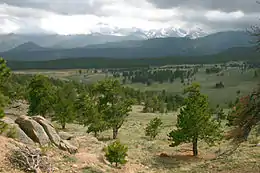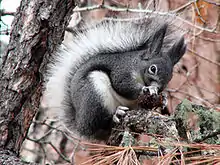Rocky Mountain ponderosa pine forest
The Rocky Mountain ponderosa pine forest is a forest plant community at an elevation of 2,000–2,700 metres (6,600–8,900 ft) in the U.S. state of Colorado, depending on soil moisture.[1][2]:89 It is an important temperate coniferous forest ecoregion, including some endemic wildlife and grass species that are only found in this ponderosa pine (Pinus ponderosa) habitat.

Ecology
.jpg.webp)
The vitality and regeneration of this Pinus ponderosa forest depends on ample seeds, adequate moisture, and a temperature of 55 °F (13 °C) for germination and early survival. Once the seed germinates, it grows a tap root 20 inches (51 cm) into the ground. This tree likes uneven aged stands and is shade intolerant. Management practices for the forest include group selection cutting and prescribed controlled burn fires. The bark of ponderosa pine is very thick so older trees can withstand fire to a certain extent. The Quaking aspen (Populus tremuloides) grow well in the forest. Sucker production after a fire is high (50,000 suckers per hectare) but survival is low. There is less canopy cover in a ponderosa pine community compared to a lodgepole pine (Pinus contorta) and spruce/fir community, resulting in more grasses, forbs, and shrubs. The high species richness in this community makes it preferred by grazing animals such as elk (Cervus elaphus), deer (Odocoileus hemionus), and moose (Alces alces).
Climate
Of the 14–20 inches (35–50 cm) of annual precipitation, 60% of that falls from the month of April to the month of September in the form of thunderstorms. During these months there is high evapotranspiration because Populus tremuloides intercept a lot of the precipitation. The average temperature for this community is, on average, warmer than other conifer communities studied. The average temperature is approximately 5 to 8 °C (41 to 46 °F), creating 50-100 frost-free days per year.[1]:7
Wildlife
The ponderosa pine forest, unlike the lodgepole pine and spruce/fir forests, supports numerous mammal species including Abert's squirrel (Sciurus aberti), which only lives in ponderosa pine communities.[3] S. aberti usually prefers a cluster of trees and feeds on the seeds of the cones. S. aberti has also adapted to the chemicals ponderosa pine produces for protection by targeting the trees that have lowered chemical levels. Pygmy nuthatches (Sitta pygmaea) are also adapted to ponderosa pine woodlands.[4] Another species that can be supported by ponderosa pine is the Colorado chipmunk (Tamias quadrivitattus). T. quadrivitattus helps spread the seeds of the ponderosa pine by spreading out and burying its caches. This results in the seeds being further from the trees and better germination rates. This community also hosts the gopher snake (Pituophis catenifera), which burrows into gopher holes. Also, ponderosa pine provides habitat for the cougar (Puma concolor) and the bobcat (Lynx rufus) as well as birds as western tanager (Piranga ludoviciana), wild turkey (Meleagris gallopavo), mountain bluebird (Sialia currucoides), and white-breasted nuthatch (Sitta carolinensis). The species present in this area affect the vegetation and provide aesthetic value for the people who use this area recreationally.
Recreation
The ponderosa pine forest is a favored location for summer cabins and is often easily accessed. Much camping and four-wheel driving happens during the summer in the area also. Hunting is favored in the ponderosa pine forest because the trees are more spaced out than other conifer forests making for better range of sight, and the forest is lower and has less snow.
Soil erosion
Soil compaction is an issue in this forest. Soil compaction can alter what grows in an area, which will affect the vegetation and thus the outcome of this study. This high amount of activity, plus vigorous summer thunderstorms, can cause erosion of the soil.
See also
References
- Peet, RK (1981). "Forest vegetation of the Colorado front range". Vegetatio. 45 (1): 3–75.
- Peet, R. K. (1988). "Forests of the Rocky Mountains". In Barbour, M. G.; Billings, W. D. (eds.). North American terrestrial vegetation. New York: Cambridge University Press. pp. 63–101. ISBN 978-0-521-55986-7.
- Patton, David R (1975). "Abert squirrel cover requirements in Southwestern ponderosa pine". Fort Collins, Colorado: U.S. Department of Agriculture, Forest Service, Rocky Mountain Forest and Range Experiment Station. Res. Pap. RM-145.
- Hughes, John. "Pygmy Nuthatch". Flathead Audubon Society.
